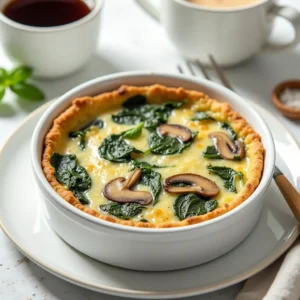Introduction
 A healthy quiche is a versatile dish that combines delicious flavor with wholesome ingredients. By choosing nutritious options like whole-grain crusts, low-fat custards, and vegetable-rich fillings, you can enjoy a guilt-free quiche for any meal of the day. Whether you prefer a crustless version or one with a sweet potato base, there are countless ways to craft a low-fa t quiche that suits your taste while boosting nutritional value.
A healthy quiche is a versatile dish that combines delicious flavor with wholesome ingredients. By choosing nutritious options like whole-grain crusts, low-fat custards, and vegetable-rich fillings, you can enjoy a guilt-free quiche for any meal of the day. Whether you prefer a crustless version or one with a sweet potato base, there are countless ways to craft a low-fa t quiche that suits your taste while boosting nutritional value.
The key to creating a truly exceptional quiche lies in selecting healthy, high-quality ingredients. Incorporating nutrient-rich vegetables, lean proteins, and wholesome dairy options not only enhances the flavor but also boosts its nutritional profile. With the right choices, a quiche can provide essential vitamins, minerals, and energy, making it both a delicious and health-conscious meal choice. By focusing on healthier ingredients, you can enjoy this classic dish guilt-free while nourishing your body.
Quiche is a versatile dish that can easily be transformed into a healthy quiche with the right ingredient choices. Whether you’re making a crustless version or opting for nutrient-packed fillings, a healthy quiche recipe can be both satisfying and nutritious.
Understanding Quiche Components
Every healthy quiche consists of three parts: the crust, filling, and custard. Making thoughtful changes to these components can result in a truly nutritious quiche without compromising on flavor.
The crust is typically made from a mix of flour and butter, providing a flaky, buttery foundation. However, traditional crusts are often high in refined carbohydrates and saturated fats, which can impact health when consumed in excess.
The filling is where quiches shine in variety. Common ingredients include vegetables, proteins, and cheeses, which can transform the dish into a nutrient-rich meal or a calorie-heavy indulgence depending on the choices made.
The custard binds everything together, typically combining eggs and heavy cream. While these ingredients lend a creamy texture, they also contribute saturated fats and cholesterol.
To create a healthier quiche, each component can be modified without sacrificing flavor. Opting for whole-grain or vegetable-based crusts, adding nutrient-dense fillings like leafy greens or lean proteins, and lightening the custard with low-fat milk or egg whites can enhance the dish’s nutritional profile. By carefully balancing ingredients, quiche can be a wholesome and satisfying meal suitable for a wide range of diets.
The Crust: Making Healthier Choices
Traditional crusts can be replaced with whole-grain alternatives or vegetable-based options to create a guilt-free quiche. For those looking for a carb-free option, a crustless low-fat quiche is an excellent choice.
1. Whole-Grain Crusts:
Using whole-wheat flour instead of white flour boosts the fiber content of the crust, aiding digestion and promoting satiety. Whole-grain crusts also provide additional nutrients like B vitamins and minerals that refined flours lack.
2. Vegetable-Based Crusts:
Vegetable alternatives like sweet potato, zucchini, or cauliflower crusts are excellent choices for reducing refined carbs. A sweet potato crust provides natural sweetness and vitamins A and C, while cauliflower crust is low in calories and carbohydrates, making it ideal for those following low-carb diets.
3. Crustless Quiche:
For the most calorie-conscious option, a crustless quiche eliminates the crust entirely. By focusing on the filling and custard, you can reduce fat and carbohydrate intake significantly while still enjoying the heart of the dish.
These substitutions not only lower the calorie count but also incorporate extra nutrients into the quiche. For example, choosing a cauliflower crust provides antioxidants and fiber, while a whole-grain crust offers better glycemic control. Experimenting with these options allows you to create a base that supports both health and flavor.
The Custard: Lightening Up the Base
The key to a creamy but healthy quiche lies in the custard. Swap heavy cream for low-fat milk or plant-based alternatives to ensure a nutritious quiche with fewer calories.
1. Low-Fat or Plant-Based Milk:
Swapping heavy cream for low-fat milk, skim milk, or plant-based alternatives like almond, oat, or coconut milk can significantly reduce fat content. For instance, unsweetened almond milk adds creaminess with a fraction of the calories and no saturated fat.
2. Egg Whites or Substitutes:
Instead of using whole eggs exclusively, incorporating egg whites or cholesterol-free egg substitutes lowers the calorie and cholesterol levels. For example, two egg whites can replace a whole egg without altering the custard’s binding properties.
3. Pureed Vegetables:
To boost creaminess naturally, consider adding pureed vegetables like cauliflower, butternut squash, or even white beans. These add depth of flavor and nutrients such as fiber and vitamins while reducing the need for high-fat dairy.
Combining these techniques can transform your quiche custard into a healthier yet equally indulgent base. A custard made with almond milk, egg whites, and a touch of pureed cauliflower provides all the creaminess you crave without the guilt. These substitutions make it possible to enjoy the classic richness of quiche while supporting your health goals.
Filling Ingredients: Nutritious Additions
 The filling is the heart of a quiche and the best opportunity to incorporate nutrient-dense ingredients. Opting for wholesome vegetables, lean proteins, and carefully chosen cheeses ensures your quiche is flavorful and healthy.
The filling is the heart of a quiche and the best opportunity to incorporate nutrient-dense ingredients. Opting for wholesome vegetables, lean proteins, and carefully chosen cheeses ensures your quiche is flavorful and healthy.
1. Vegetables:
Adding vegetables not only boosts the quiche’s nutritional value but also enhances its flavor and texture. Popular choices include:
- Leafy Greens: Spinach, kale, and Swiss chard are rich in vitamins A, C, and K, as well as minerals like iron and calcium. They also add vibrant color and a slight crunch.
- Cruciferous Vegetables: Broccoli and cauliflower bring fiber, antioxidants, and a satisfying texture. These vegetables can be lightly steamed before incorporating to ensure they cook evenly.
- Other Options: Mushrooms, bell peppers, zucchini, and tomatoes are excellent for adding variety, sweetness, or umami flavors while packing in additional nutrients.
2. Proteins:
Including lean protein options ensures a balanced meal. Some healthier protein choices include:
- Lean Meats: Turkey bacon, chicken sausage, or lean ham offer lower-fat alternatives to traditional bacon or sausage.
- Seafood: Smoked salmon or shrimp provide omega-3 fatty acids, which are beneficial for heart and brain health.
- Plant-Based Proteins: Tofu, tempeh, and legumes like chickpeas or black beans are ideal for vegetarian quiches. They are high in protein, fiber, and essential nutrients.
3. Cheeses:
Cheese adds richness to quiche but can also increase saturated fat and calorie content. Opt for:
- Low-Fat Varieties: Part-skim mozzarella, ricotta, and feta are lighter options that still deliver creaminess.
- Strong-Flavored Cheeses: Parmesan, Gruyère, or blue cheese offer bold flavors, allowing you to use less without sacrificing taste.
Moderation and Balance:
When assembling your filling, aim for a balance of textures and flavors. Combine fiber-rich vegetables with lean proteins and use cheese sparingly to enhance taste without overwhelming the dish. Moderation ensures the quiche remains satisfying and nutritious.
By focusing on nutrient-dense fillings, your quiche becomes a wholesome meal that provides essential vitamins, minerals, and proteins without excessive fats or calories.
Herbs and Spices: Enhancing Flavor Without Extra Calories
Herbs and spices are the secret to elevating your quiche’s flavor profile without relying on high-calorie ingredients like excess cheese or cream.
Fresh Herbs:
Incorporate herbs like chives, basil, thyme, parsley, or dill to add aromatic freshness and subtle complexity. For example:
- Chives provide a mild onion flavor.
- Basil adds a hint of sweetness.
- Thyme offers earthy undertones that pair well with savory ingredients.
Spices:
A dash of spices can make your quiche unique:
- Nutmeg: Adds warmth and complements creamy custards.
- Black Pepper: Enhances savory notes without the need for added salt.
- Paprika: Provides a mild smoky kick.
Herbs and spices not only improve flavor but also offer health benefits, such as antioxidants and anti-inflammatory properties. With these additions, you can craft a quiche that is both delicious and health-conscious.
Frequently Asked Questions (FAQs)
1. Can a quiche be healthy?
Yes, quiche can be made healthy with thoughtful ingredient choices. Using whole-grain or vegetable-based crusts, incorporating nutrient-rich vegetables, lean proteins, and low-fat dairy, and substituting cream with lighter options make it a nutritious meal.
2. What is a healthy alternative to cream in quiche?
Healthy alternatives to cream include low-fat milk, skim milk, or plant-based options like almond, oat, or coconut milk. You can also use pureed vegetables such as cauliflower or butternut squash for a creamy texture.
3. What nutrients are in quiche?
Quiche can provide a variety of nutrients, including protein from eggs and cheeses, fiber and vitamins from vegetables, and healthy fats from lean meats or plant-based proteins. The specific nutrients depend on the ingredients used.
4. What does quiche contain?
A traditional quiche typically contains a crust, a custard base made of eggs and cream, and a filling with ingredients like vegetables, meats, and cheeses. Healthier variations can modify these components for better nutrition.
Mushrooms are an excellent addition to any healthy quiche. They are low in calories, rich in antioxidants, and bring a savory, umami flavor to the dish. For a detailed and delicious mushroom quiche recipe, check out this guide from SoftDishes. It provides step-by-step instructions to prepare a flavorful mushroom quiche that can be easily adapted to fit a healthier diet.
Conclusion
Creating a healthier quiche is all about making smart ingredient choices and employing thoughtful cooking techniques. By swapping traditional crusts for whole-grain or vegetable-based alternatives, lightening the custard with low-fat or plant-based milk, and focusing on nutrient-dense fillings like leafy greens, lean proteins, and low-fat cheeses, you can transform this classic dish into a wholesome, guilt-free option. Herbs and spices further enhance flavor without adding calories, while proper cooking methods ensure a perfect texture every time.
The beauty of quiche lies in its versatility, allowing endless opportunities for experimentation. Whether you prefer a crustless quiche or a sweet potato base, or if you’re exploring new combinations of vegetables and proteins, you can create a dish that suits your tastes and dietary needs. Embrace creativity in the kitchen, and enjoy crafting personalized, healthy quiche variations that are both delicious and nutritious for any meal of the day.

2 thoughts on “Healthy Quiche Recipe”